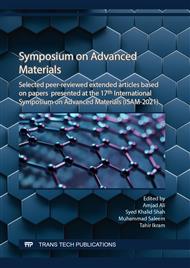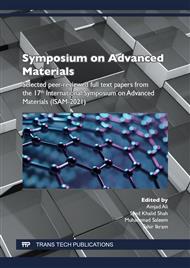p.13
p.19
p.27
p.37
p.43
p.53
p.61
p.69
p.75
A Study of Aluminum Doped ZnO Thin Films Developed via a Hybrid Method Involving Sputter Deposition and Wet Chemical Synthesis
Abstract:
Transparent conducting oxides (TCO) are semiconducting materials that are electrically conductive as well as optically transparent thus making them suitable for application in photovoltaics, transparent heat transfer windows, electrochromic windows, flexible display, and transparent electronics. One of the methods to enhance the conductivity of metal oxides is doping, however, it can adversely affect the optical transparency of metal oxide. Aluminum (Al) doped zinc (Zn) oxide (AZO) is an important TCO material whose optoelectronic properties heavily rely on the Al doping level. There are various methods to develop AZO thin films. However, since Al and Zn are high vapor pressure materials, and their precise content control isn’t that easy, that’s why we dedicated this study to devise a facile method of Al doping into the ZnO structure. We report a twostep synthesis route to develop AZO thin films over glass substrates. Sub stoichiometric zinc oxide (ZnOx) thin films were sputter deposited over glass employing RF magnetron sputtering at 70W and 9 x 10-3 Torr Ar pressure. To mitigate Zn losses during annealing at 450 °C, the films were first oxidized up to 200 °C in air so as to convert ZnOx into stoichiometric ZnO. To incorporate Al into the ZnO structure, Al was spin coated on top of ZnO from its stabilized sol of 0.07 molar aluminum nitrate nonahydrate in ethanol. The samples were subsequently annealed at 450 °C for 2h in air with a controlled heating ramp of 3 °C/min. The film morphology, microstructure, electronic, and optical characteristics were explored employing scanning electron microscopy, energy dispersive x-ray spectroscopy, Hall effect measurements, and UV-Vis-NIR spectrophotometry, respectively. We found that both the Al and oxygen (O) content affect the optoelectronic behavior of AZO. Even without Al doping, O deficient samples were found to be sufficiently conductive, however, the ZnOx is less transparent relative to O rich stoichiometric ZnO. Furthermore, if ZnOx is annealed at higher temperatures, it causes Zn losses, since Zn is a relatively high vapor pressure material. It degrades the film morphology as well. Once we have ZnO we can confidently treat it at 450 °C to allow Al diffusion into the interiors of the ZnO film. We found that AZO produced via this method is sufficiently conductive as well as transparent.
Info:
Periodical:
Pages:
53-59
Citation:
Online since:
September 2022
Authors:
Price:
Сopyright:
© 2022 Trans Tech Publications Ltd. All Rights Reserved
Share:
Citation:



